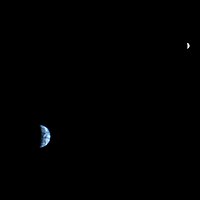
Back تسارع مدي Arabic Прыліўное паскарэнне Byelorussian Приливно ускорение Bulgarian Acceleració de marea Catalan Тулăмла хăвăртлану CV Aceleración de marea Spanish Itsasaldiaren azelerazio Basque شتاب جزر و مدی Persian Accélération par effet de marée French Accelerazione secolare della Luna Italian

Tidal acceleration is an effect of the tidal forces between an orbiting natural satellite (e.g. the Moon) and the primary planet that it orbits (e.g. Earth). The acceleration causes a gradual recession of a satellite in a prograde orbit (satellite moving to a higher orbit, away from the primary body, with a lower orbital velocity and hence a longer orbital period), and a corresponding slowdown of the primary's rotation. See supersynchronous orbit. The process eventually leads to tidal locking, usually of the smaller body first, and later the larger body (e.g. theoretically with Earth-Moon system in 50 billion years).[1] The Earth–Moon system is the best-studied case.
The similar process of tidal deceleration occurs for satellites that have an orbital period that is shorter than the primary's rotational period, or that orbit in a retrograde direction. These satellites will have a higher and higher orbital velocity and a shorter and shorter orbital period, until a final collision with the primary. See subsynchronous orbit.
The naming is somewhat confusing, because the average speed of the satellite relative to the body it orbits is decreased as a result of tidal acceleration, and increased as a result of tidal deceleration. This conundrum occurs because a positive acceleration at one instant causes the satellite to loop farther outward during the next half orbit, decreasing its average speed. A continuing positive acceleration causes the satellite to spiral outward with a decreasing speed and angular rate, resulting in a negative acceleration of angle. A continuing negative acceleration has the opposite effect.
- ^ "When Will Earth Lock to the Moon?". Universe Today. 2016-04-12. Retrieved 2022-01-05.